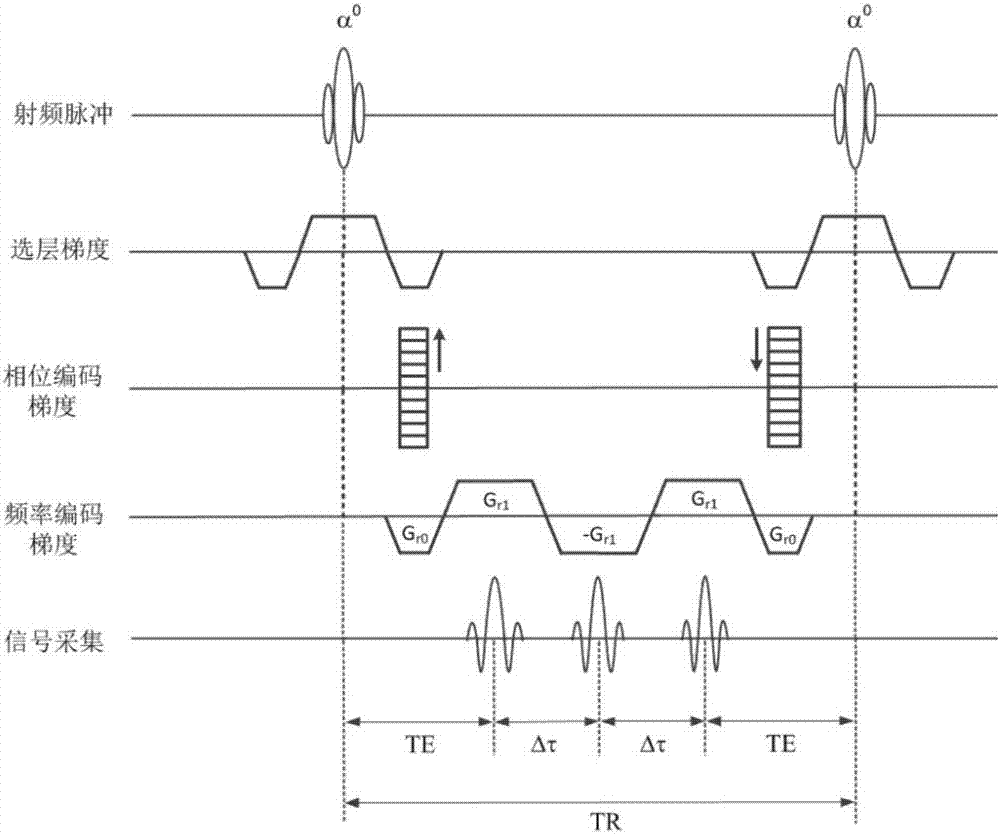Steady-state procession gradient multi-echo water and grease separation imaging method
A technology of water-fat separation and imaging method, which is applied in the fields of measurement using nuclear magnetic resonance image system, magnetic resonance measurement, medical science, etc. It can solve the problems of long scanning time, no consideration of phase winding, and large problems of reasonable selection of TE and TR. Difficulty and other issues to achieve the effect of improving accuracy and suppressing motion artifacts
- Summary
- Abstract
- Description
- Claims
- Application Information
AI Technical Summary
Problems solved by technology
Method used
Image
Examples
Embodiment 1
[0037] Embodiment 1: Installed in the sequence library of the 1.5T MRI system figure 1 or image 3 In the sequence shown, the RF pulse adopts the minimum phase SLR waveform, the pulse width is 1ms or shorter, the time of the gradient up and down is 0.1ms or shorter, and the number of frequency codes is set to DIM1=160 in the sequence parameter table, and the phase code is The number is set to DIM2=256, the number of phase codes in the layer selection direction is set to DIM3=32, the number of chemical shift phase codes is set to DIM4=3, the field of view is set to FOV=220mm, the receiver bandwidth is set to BW=125kHz, Δτ is preferably 1 / Δf / 3=1.5ms, the echo time of each group of echoes is t in turn 1 = 4.1ms, t 2 = 5.6ms, t 3 =7.1ms, the corresponding echo encoding phases are -π / 6, π / 2 and 7π / 6 in turn, and set TE=4.5ms, TR=12ms, Δf≈220Hz. Then, install and execute the signal debugging module, scanning module, data acquisition and processing module, and water-fat separati...
Embodiment 2
[0061] In the case of low field strength (such as 0.35T), the signal debugging module and scanning module call figure 2 or Figure 4 For the imaging sequence shown, set TE = 1 / Δf / 4 and Δτ = 1 / Δf / 4 in the parameter table, and the chemical shift encoding phases of the echo peaks are π / 2 and π respectively, and then scan and signal in a similar manner as above processing to get the quadrature phase diagram S 0 and inverse graph S 1 , and finally the water-fat separation module performs data processing on the two images in the following way:
[0062]
[0063]
[0064] First, based on Calculate the phase angle φ of the water model image K obtained from the reference scan 0 (i, j); Then, scan the human body to get the image S 0 and S 1 , the pixels (i,j) of each image are multiplied by get
[0065] S' 0 = S w +i·S f (7)
[0066] S 1 '=(S w -S f ) e i2πνΔτ (8)
[0067] Therefore, the water image and the fat image are calculated as S w =RE(S' 0 ), S f =IM(...
PUM
 Login to View More
Login to View More Abstract
Description
Claims
Application Information
 Login to View More
Login to View More - R&D
- Intellectual Property
- Life Sciences
- Materials
- Tech Scout
- Unparalleled Data Quality
- Higher Quality Content
- 60% Fewer Hallucinations
Browse by: Latest US Patents, China's latest patents, Technical Efficacy Thesaurus, Application Domain, Technology Topic, Popular Technical Reports.
© 2025 PatSnap. All rights reserved.Legal|Privacy policy|Modern Slavery Act Transparency Statement|Sitemap|About US| Contact US: help@patsnap.com



